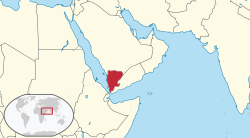
Back الجمهورية العربية اليمنية Arabic الجمهوريه العربيه اليمنيه ARZ عربی یمن جومهوریتی AZB Еменская Арабская Рэспубліка Byelorussian Йеменска арабска република Bulgarian Republik Arab Yemen Breton Sjeverni Jemen BS Iemen del Nord Catalan Severní Jemen Czech Gogledd Iemen Welsh
You can help expand this article with text translated from the corresponding article in Arabic. (May 2024) Click [show] for important translation instructions.
|
Yemen Arab Republic | |||||||||
|---|---|---|---|---|---|---|---|---|---|
| 1962–1990 | |||||||||
| Anthem: "Peace to the Land" (1962–1978) إرادة أمة 'Iiradat 'Uma "A Nation's Will" (1978–1990) | |||||||||
 Location of North Yemen (red) | |||||||||
| Capital and largest city | Sanaa | ||||||||
| Official languages | Arabic | ||||||||
| Religion | Islam (official, predominantly Zaydi Shia and Shafi'i Sunni Islam) | ||||||||
| Demonym(s) | Yemeni | ||||||||
| Government | Unitary Nasserist Islamic republic under a military junta (1962–ca. 1978)[1][2] | ||||||||
| President | |||||||||
• 1962–1967 (first) | Abdullah al-Sallal | ||||||||
• 1978–1990 (last) | Ali Abdullah Saleh | ||||||||
| Prime Minister | |||||||||
• 1962–1963 (first) | Abdullah al-Sallal | ||||||||
• 1983–1990 (last) | Abdul Aziz Abdul Ghani | ||||||||
| Legislature | Consultative Council | ||||||||
| Historical era | Cold War | ||||||||
| 26 September 1962 | |||||||||
| 1 December 1970 | |||||||||
| 22 May 1990 | |||||||||
| Area | |||||||||
• Total | 136,000 km2 (53,000 sq mi) | ||||||||
| Currency | North Yemeni rial | ||||||||
| Time zone | UTC+3 | ||||||||
| Calling code | +967 | ||||||||
| |||||||||
| Today part of | Yemen | ||||||||
The Yemen Arab Republic (YAR; Arabic: الجمهورية العربية اليمنية al-Jumhūriyyah al-‘arabiyyah al-Yamaniyyah, French: République arabe du Yémen), commonly known as North Yemen or Yemen (Sanaʽa), was a country that existed from 1962 to 1990 in the northwestern part of what is now Yemen.[3] Its capital was at Sanaa. It united with the People's Democratic Republic of Yemen (commonly known as South Yemen) on 22 May 1990 to form the current Republic of Yemen.
- ^ "Constitution of the Yemen Arab Republic, 1970". al-bab.com. Retrieved 8 February 2018.
- ^ Bühler, Konrad G. (8 February 2001). State Succession and Membership in International Organizations. Martinus Nijhoff Publishers. ISBN 9041115536. Retrieved 13 February 2018.
- ^ The United States extended diplomatic recognition to the Yemen Arab Republic (North Yemen) on 19 December 1962, The Times, 20 December 1962.

